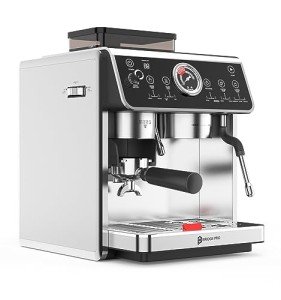The Art of Italian Espresso Machines: A Brewed Tradition
Italian espresso machines are not simply home appliances; they are an integral part of Italy's rich coffee culture, representing a mix of artistry, engineering, and design. Coffee aficionados worldwide recognize the significance of high-quality espresso, a staple of Italian life and food. This article explores the history, mechanics, types, and aspects to consider when purchasing an Italian espresso machine, showing the depth of this cherished beverage and its developing techniques.
History of Espresso Machines
The espresso machine's development dates back to the early 20th century in Italy, where coffee was not simply a drink but an essential social routine. The preliminary attempts to brew espresso begun with simple, stove-top designs, slowly progressing into complex machines that could reproduce the perfect brew.
- 1901-- The First Espresso Machine: The first steam-powered espresso machine, called the "Ideale," was established by Luigi Bezzera. This equipment marked a turning point in espresso developing.
- 1938-- The Lever Machine: The introduction of the lever machine made it simpler to manage the pressure used in espresso extraction, boosting flavor consistency.
- 1947-- The Automatic Machine: Reaching more consumers, Gaggia released the very first automatic espresso machine, more popularizing espresso bars.
- 2007-- The Digital Age: Technological advancements led to the birth of completely programmable machines, enabling users to customize their developing settings to achieve an individualized coffee experience.
Key Features of Italian Espresso Machines
Italian espresso machines embody precision, workmanship, and innovation. Here are some essential elements that highlight their significance:
| Feature | Description |
|---|---|
| Boiler Type | Figures out how heat is generated and preserved. Common types consist of single boiler, dual boiler, and heat exchanger. |
| Group Heads | Where the coffee is brewed; commercial machines typically have numerous group heads for performance. |
| Pressure Control | Important for attaining the best espresso; most machines operate at 9 bars of pressure. |
| Frothing Capabilities | The steam wand enables milk frothing, vital for beverages like cappuccino and latte. |
| Construct Quality | The products used (stainless-steel, brass, etc) impact durability and heat retention. |
Types of Italian Espresso Machines
Selecting the ideal machine depends upon user choices, budget, and meant use. Below are the main types of Italian espresso machines:
Manual Espresso Machines
- Pros: Offer full control over the brewing process, permitting a tailored touch.
- Cons: Require skill and practice, can be labor-intensive.
Semi-Automatic Machines
- Pros: Provide a balance in between automated and manual processes; users control water circulation.
- Cons: Can have a steeper learning curve than fully automatic machines.
Fully Automatic Machines
- Pros: Simplify the developing procedure with push-button operations; perfect for newbies.
- Cons: May sacrifice a few of the subtleties of manual developing.
Super-Automatic Machines
- Pros: Grind, tamp, brew, and froth immediately; hassle-free for busy lifestyles.
- Cons: Less control over the brewing variables, capacity for a less authentic espresso experience.
Purchasing Guide: Factors to Consider
Selecting the ideal Italian espresso machine can be complicated, however considering the following aspects can streamline the decision-making process:
- Budget: Italian espresso machines range from affordable to high-end designs, so set a budget upfront.
- Use Frequency: Evaluate how typically you will use the machine; daily users might desire a more long lasting choice.
- Space: Measure your cooking area or counter area; some machines can be large and require adequate clearance.
- Maintenance: Consider ease of cleaning; machines with detachable parts or integrated cleaning features may reduce upkeep.
- User Skill Level: Beginners may prefer fully or semi-automatic machines, while experienced baristas can manage manual machines.
- Brand name Reputation: Research brands known for quality, such as Breville, Gaggia, and La Marzocco.
Popular Italian Espresso Machine Brands
Italian workmanship is renowned for producing a few of the very best espresso machines worldwide. Here are top brand names worth considering:
- Gaggia: Known for its home espresso machines and cost.
- La Marzocco: A premium brand name known for its commercial-grade machines and innovative innovation.
- Rancilio: Renowned for its resilient develop and professional-quality machines appropriate for home and commercial use.
- Sage/Breville: Offers advanced functions and easy to use designs, best for both amateurs and enthusiasts.
FAQs
What is the distinction between espresso and routine coffee?
Espresso is a focused coffee brewed by forcing warm water through finely-ground coffee under pressure. It has a thicker consistency, richer flavor, and greater caffeine concentration than routine coffee.
Can I make milk-based drinks with an espresso machine?
Yes, many Italian espresso machines come with a steam wand to froth milk for drinks like cappuccinos, lattes, and macchiatos.
How typically should I clean my espresso machine?
Regular maintenance is necessary. Normally, a thorough cleaning is suggested every couple of weeks, while descaling should be done every 1 to 3 months, depending on water hardness.
What is the perfect pressure for brewing espresso?
The perfect pressure for developing espresso is around 9 bars. This pressure guarantees the optimal extraction of tastes from the coffee premises.
Are more pricey machines worth the investment?
Higher-end machines frequently utilize much better materials and technology, providing enhanced resilience and more constant outcomes. For major coffee enthusiasts, investing in an excellent machine can elevate the espresso experience significantly.
Italian espresso machines are a lot more than mere brewing gadgets; they are a celebration of a cultural custom that has actually affected coffee consumption worldwide. With numerous models offered to fit any user's needs-- varying from amateurs to seasoned baristas-- there is an Italian espresso machine perfectly matched for everybody. As you start your espresso journey, comprehending the history, mechanics, and options will improve your experience and gratitude for this time-honored drink. Whether Espresso Machines Under £500 seek to recreate a coffee shop ambiance at home or fine-tune your brewing strategy, these machines are capable of delivering unforgettable cups of espresso adorned with the rich history of Italian coffee culture.

